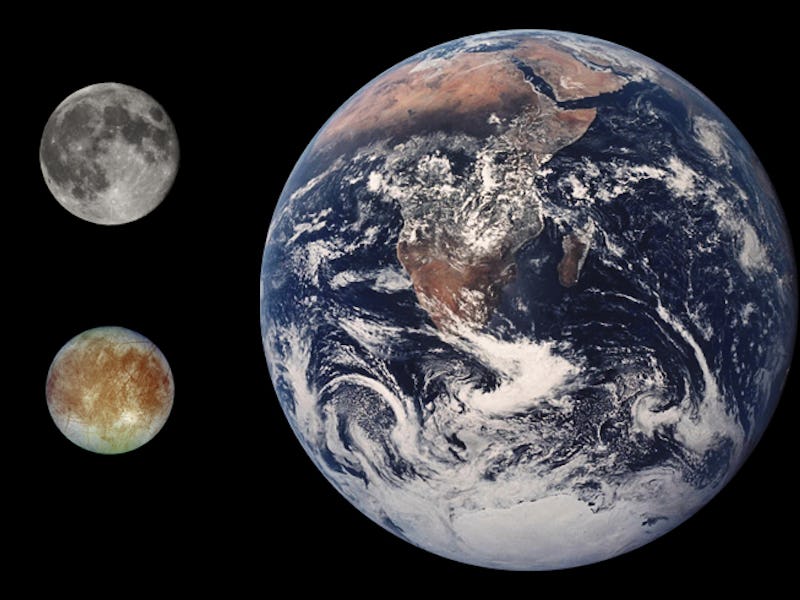
Jupiter’s moon Europa is high on the list of celestial bodies that might harbor intelligent extraterrestrial life for one key reason: It’s rumored to have water. So far, no human spacecraft have managed to physically scoop any of this H2O up, but telescopes have previously revealed glimpses of what looked like water plumes rising from its surface. Monday’s news, published in Nature Astronomy, gives us an even closer look: In a story bound to excite alien hunters, NASA, and Tom DeLonge alike, it appears that the Galileo spacecraft hit water vapor erupting from Europa’s surface 20 years ago and didn’t realize what it was until now.
The team behind the paper write that they were motivated to dig back into Galileo’s data by the images captured by the Hubble Space Telescope in 2016, which suggested plumes of water were popping out of cracks in Europa’s surface. Looking at two-decade-old data collected by the Galileo probe, which launched in 1989 on a journey toward Jupiter, they checked to see whether the plumes might have appeared elsewhere. Bingo.
Their analysis of data from Galileo’s magnetometer showed that, when the spacecraft swooped down toward Europa’s surface on December 16, 1997, it recorded a sudden shift in the moon’s magnetic field strenth. As Gizmodo reports, at the time that Galileo was active, researchers blamed the anomaly on the influence of Jupiter’s magnetic field, but the new analysis shows that Galileo was probably just passing through a plume of water. The researchers seem pretty confident in this analysis:
We show that the location, duration and variations of the magnetic field and plasma wave measurements are consistent with the interaction of Jupiter’s corotating plasma with Europa if a plume with characteristics inferred from Hubble images were erupting from the region of Europa’s thermal anomalies. These results provide strong independent evidence of the presence of plumes at Europa.
Water on Europa would be a huge deal. There’s evidence of an underground ocean on the moon that sends chemicals bubbling up to the icy surface. If some chemicals can get up and out, scientists think, other chemicals can get into the ocean. Think of it as a portal into an environment that could sustain life.
Mike Brown of Caltech, who authored a 2013 study on Europa’s surface, said in a statement: “Europa’s ocean is not isolated … the ocean and the surface talk to each other and exchange chemicals. That means that energy might be going into the ocean, which is important in terms of the possibilities for life there.”
What’s next? We’re going back. “Our detection of a plume based on the Galileo data certainly strengthens the case for future exploration of Europa,” space scientist and study author Xianzhe Jia said, reported the Guardian.
But we’ll have to wait until the 2020s, when NASA’s Europa Clipper mission plans to launch. The European Space Agency is launching a mission called the Jupiter Icy Moons Explorer, or Juice, in 2022.